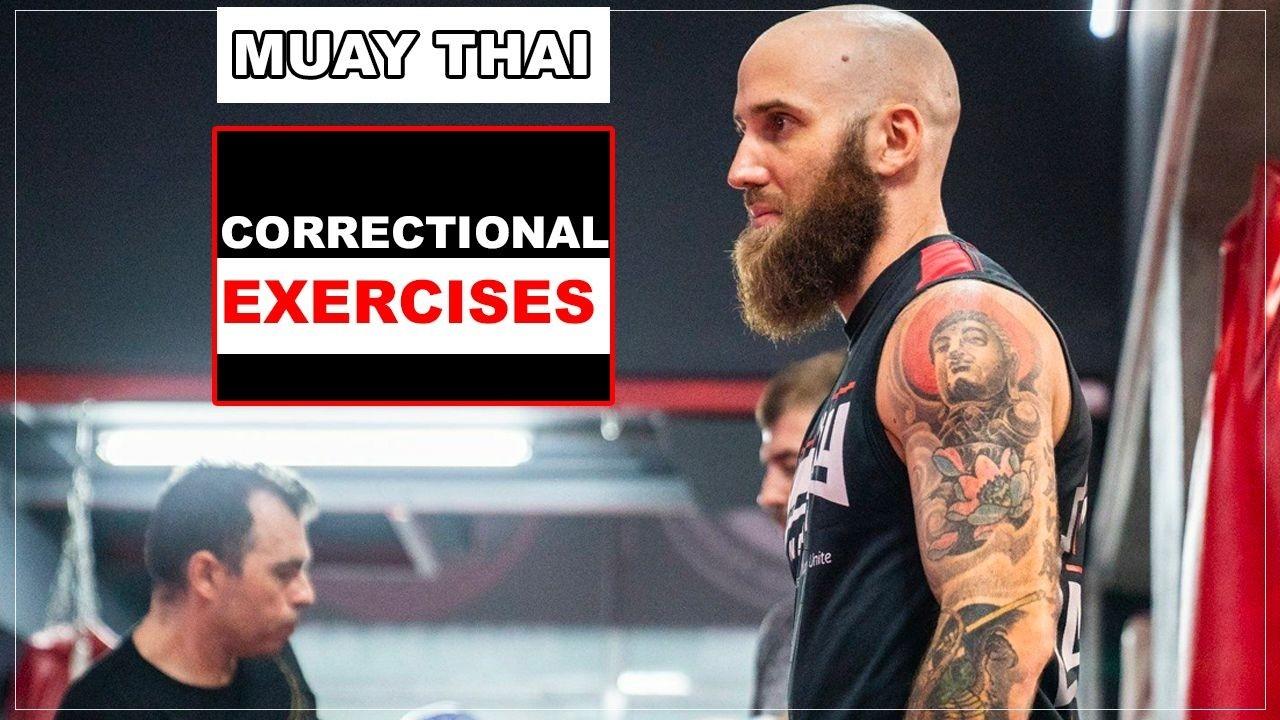Muay Thai Correctional Exercises

DIAGNOSE THE PROBLEM & GET YOUR TECHNIQUE CORRECT
By Andrew Bryan

Often when trying to learn a new technique, a martial artist or coach will be too bogged down in what the correct technique is for a fighter rather than how to diagnose where the problem is occurring in a given technique, and how to fix it.
It can be very frustrating if you can’t get a technique right but also can’t identify where it is going wrong. Today we will be examining the most common problems with punches and low kicks, as well as exercises to correct the form on each.
I’ve seen people trying to demonstrate the low kick for others with something along these lines:
"No, no. Watch. You're doing it like this. Try it like this!"
While I am all for people trying to teach and help one another, we also have to realize that sometimes a person knows what they should be doing but can’t co-ordinate themselves to be able to do it. That is where these exercises come in.
These are all exercises you can do at home with no equipment and will relate directly to your shadowboxing.
Problem Area 1: JAB
Most Muay Thai fighters telegraph their jab thanks to improper technique. There are two common issues that cause this telegraph: leading with the foot and flaring the elbow.
If you are stepping with your jab, the foot and hand should move together in perfect sync. If your jab leads and your foot moves, it isn’t the end of the world, because you can still hide your step. On the other hand, if your foot leads and then you jab, mid-step, this can throw off your balance.
>>> You can read my article here if balance is an area you need to work on.
Correctional Exercise 1: THE PUPPET
To build the habit of moving hands and feet in sync, I personally like the puppet string exercise, or what I affectionately refer to as "the Thunderbird" exercise.
Imagine there is a string connecting your hands to your feet. When your hands move, they move the feet along with them on this imaginary string.
In terms of getting that co-ordination down, you can really do whatever you want. You can even dance a jig if it helps you. The important thing is that when your hands move, your feet move.
If you step on the jab, you lengthen your stance as you jab. When you throw the rear straight, you shorten the stance accordingly.
Muay Thai Technique: Jab to Clinch Entry
Problem Area 2: REAR STRAIGHT
The most common complaint I hear from fighters is that they don’t feel that they are hitting hard enough. Sometimes this is a strength and conditioning issue, but usually I find that the martial artist in question isn’t hitting with optimal technique.
When you hit with power, you need your shoulder and hip to deliver the punch. Often, I find that martial artists don’t know what it feels like to have full-body rotation in the first place.
Rather than over-complicate things, I like to give a two-step correction exercise to get a martial artist on the right track to delivering with power, and then we can work out further problems from there.
Correctional Exercise 2: SWITCH STANCE
Begin in your regular stance. Now, without moving your feet, rotate your upper body into the opposite stance (southpaw if you’re an orthodox fighter, and vice versa).
Unless you’re a contortionist, you will likely feel a stretch in your rear calf. That is your body wanting to deliver an almighty punch. Keep your upper body where it is and allow your back foot to pivot so your toe is pointing straight ahead. Let your knee bend just a little and ensure that most of your body weight is on the rear leg.
Stand in this position for a while until you really feel that you’ve wrapped your head around it. When you’re comfortable, move back into your normal stance. Breathe for a moment to clear your head and now move back into our awkward stance, but make sure that as you do, you pivot your foot.
Keep moving back and forth between these two positions and, when you feel ready, start adding in your rear straight punch.
This is not the "be all and end all" for a powerful straight, but it is a great building block for delivering maximum force.
Problem Area & Correctional Exercise 3: ELBOW FLARES
Now we will get onto flaring elbows, one of the most persistent problems when it comes to punching. Flaring elbows weaken punching power and broadcast your movement. If your elbows are flaring, you cannot be an efficient puncher unless fighting someone with exceptionally poor defense.
Stand against a wall, with your jabbing shoulder very close to the wall or even touching. From the wall, we are going to fire out the jab and we cannot let our elbow bang the wall. You start the punch, you turn the fist over, do everything you normally do, but you cannot let the elbow pop out.
You can also try out the Puppet Exercise above from here.
When you’re done, turn around and do the exact same thing with your rear hand. Try to get a maximum rotation in, all without touching the wall.
If you practice each of these exercises for about two minutes every day – in what will add up to about a 10-minute technique section - you will immediately find your punching technique crisper and more powerful, but most importantly more efficient.
Power punching should not be an athletic endeavor that saps your stamina, it should be something you are able to call upon whenever you need it. If you focus on rotation and technique rather than explosive force, you will find your fight cardio improve along with your technique.
Problem Area 4: LOW KICKS
Low kicks are deceptively hard to master. I didn’t realize this until I had to create a routine of correctional exercises and technical drills for a recent fight camp. The most common issue I saw when it comes to low kicks are poor balance diminishing power and poor rotation.
First, let’s tackle balance and power delivery.
Correctional Exercise 4A: HEAD OVER FOOT
One of the first things most nak muays are told to do is crunch into a low kick. Rather than staying up high, they should bend at the abs and get down low into the kick.
This isn’t bad advice; in fact, it’s very good advice, but in order to do it well, you also need to know where to position your head. It’s quite easy to crunch with your head in the wrong position, completely throwing your balance.
The fix to this is very easy; shadowbox (or hit the bag if you have one), but when you step out to throw the low kick, make sure your head is positioned over your standing foot. This will let you kick with more power and less stumbling.
If you want a visual example of what it looks like, here is Ernesto Hoost, one of, if not the best low kicker in kickboxing.

Correctional Exercise 4B: ROLLING INTO THE KICK
This is a technique I cheekily stole from Trevor Whitman, the coach of Justin Gaethje and Rose Namajunas in the UFC, as well as from Duane Ludwig, founder of Bang Muay Thai. I will let the man himself explain it.
We swing the arms to get the body rotating, then let the kick chop through. Please understand that this is not how you should be kicking, but an exercise you can do to improve the power of your kick. It should be a supplement to your normal kicking training.
Correctional Exercise 4C: MINIMIZING KICK TELEGRAPH
S,o we’re back to the wall again, again with a very simple exercise. We stand in stance by the wall and throw out our body kick (be careful not to bang your foot). An ideal Muay Thai kick should not come out and round like a baseball bat swing, but up and in.
Although this too is an oversimplification, a kick should be one continuous movement like the big baseball bat swing, but with a narrow kicking arc that starts at an upwards trajectory and ends moving in on an angle to the target.
The best way to do this is to get into the habit of training your low kick close to a wall, and throwing your kick as you normally would but without stepping too far away from the wall as to go back to your old habit of throwing on a wide arc.
These are simple exercises you can do anywhere. If you’re unsure of why something is going wrong with your technique, the chances are high that one of these exercises will fix the issue and will certainly improve your technique.
I’d recommend a 20-minute foundational training routine using all of these exercises. You can do them in any order. Spend about two minutes on each drill (with a rest break at the 10-minute mark to let your brain refresh), training each hand and leg accordingly.
Fifteen minutes a day of concentrated focus will improve your technique far more than once or twice a week of smashing the pads and heavy bag - so be sure not to neglect the little things!
Feed Your Muay Thai Addiction!
Join our "Muay Thai Mondays" email newsletter for the latest updates on new videos, special events and everything Muay Thai!







